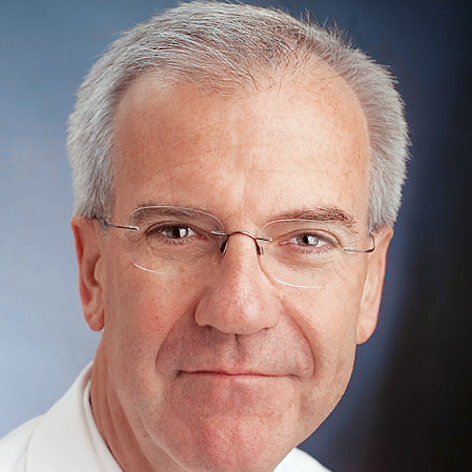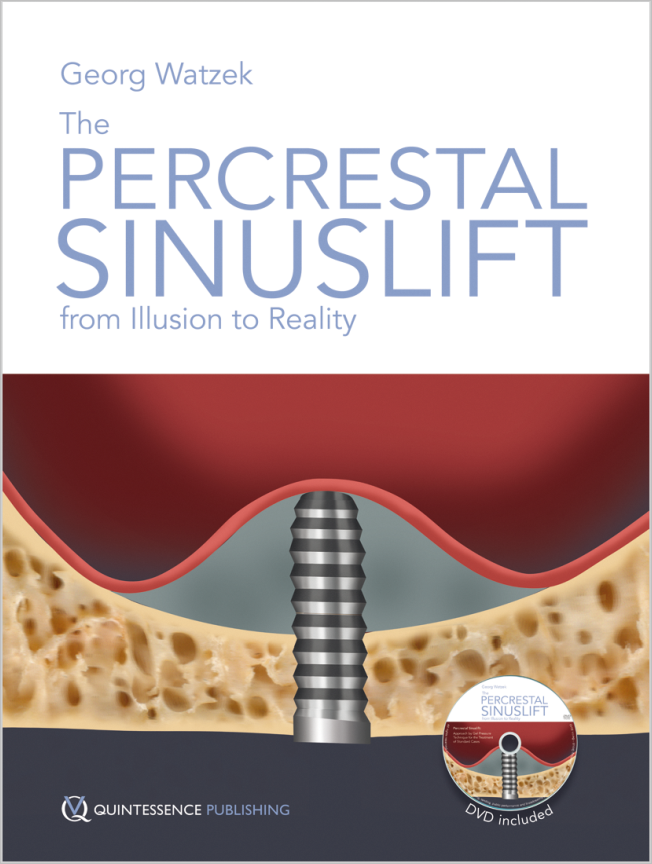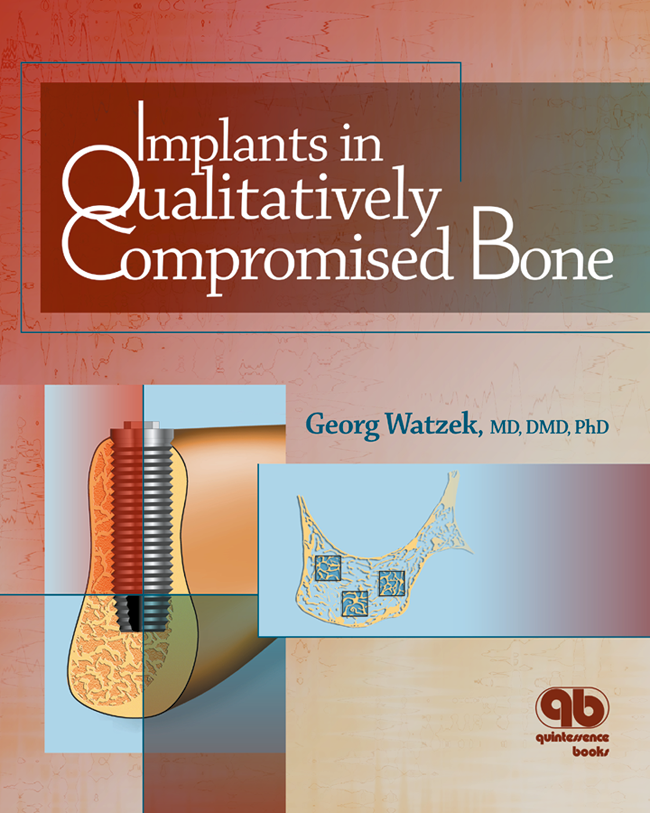Implantologie, 4/2017
Pages 27-41, Language: GermanWatzek, Georg / Lill, Werner / Friedrich, BrigitteImplantologie 1993;1:27-41The International Journal of Oral & Maxillofacial Implants, 4/2017
Online OnlyDOI: 10.11607/jomi.5536, PubMed ID (PMID): 28618433Pages e213-e220, Language: EnglishKuchler, Ulrike / Rudelstorfer, Claudia M. / Barth, Barbara / Tepper, Gabor / Lidinsky, Dominika / Heimel, Patrick / Watzek, Georg / Gruber, ReinhardPurpose: Recombinant human bone morphogenetic protein 2 (rhBMP-2) together with an absorbable collagen carrier (ACS) was approved for augmentation of the maxillary sinus prior to implant placement. The original registration trial was based on a lateral window approach. Clinical outcomes of crestal sinus augmentation with rhBMP-2 have not been reported so far.
Materials and Methods: An uncontrolled pilot trial in which seven patients with a residual maxillary height below 5 mm were enrolled to receive crestal sinus augmentation with rhBMP-2/ACS was conducted. Elevation of the sinus mucosa was performed by gel pressure. Primary endpoints were the gain in augmentation height and volume measured by computed tomography after 6 months. Evaluation of bone quality at the time of implant placement was based on histology. Secondary endpoints were the clinical and radiologic evaluation of the implants and patient satisfaction by visual analog scale (VAS) at the 2-year follow-up.
Results: Median gain in augmentation height was 7.2 mm (range 0.0 to 17.5 mm). Five patients gained at least 5 mm of bone height. Two patients with a perforation of the sinus mucosa failed to respond to rhBMP-2/ACS and underwent lateral window augmentation. The median gain in augmentation volume of the five patients was 781.3 mm3 (range 426.9 to 1,242.8 mm3). Biopsy specimens showed a cancellous network consisting of primary plexiform bone with little secondary lamellar bone. After 2 years, implants were in function with no signs of inflammation or peri-implant bone loss. Patients were satisfied with the esthetic outcomes and chewing function.
Conclusion: This pilot clinical trial supports the original concept that rhBMP-2/ACS supports bone formation, also in crestal sinus augmentation, and emphasizes the relevance of the integrity of the sinus mucosa to predict the bone gain.
Keywords: dental implants, osteoinductivity, rhBMP-2, sinus augmentation
The International Journal of Oral & Maxillofacial Implants, 5/2016
DOI: 10.11607/jomi.4326, PubMed ID (PMID): 27632272Pages 1150-1155, Language: EnglishBusenlechner, Dieter / Mailath-Pokorny, Georg / Haas, Robert / Fürhauser, Rudolf / Eder, Carina / Pommer, Bernhard / Watzek, GeorgPurpose: To compare long-term survival and marginal bone loss of immediate interantral implants in the nonaugmented maxilla subjected to immediate vs delayed loading.
Materials and Methods: Graftless maxillary cross-arch rehabilitation was performed in a total of 362 patients in the years 2004 to 2013 (1,797 implants). Of the 240 patients with immediate implants replacing their failing maxillary dentition, 81% were subjected to immediate loading and 19% to delayed loading of their 4 to 6 interantral implants (980 and 235 implants, respectively). Kaplan-Meier survival estimates were computed and marginal bone loss was evaluated in a stratified random sample of 20 patients per group.
Results: Thirty-one of 1,215 implants failed within the mean observation period of 3.9 years, and no difference in 8-year survival estimates could be seen between immediate (97.6% [95% CI: 96.7 to 98.6]) and delayed (96.6% [95% CI: 94.3 to 98.9]) loading protocols (P = .359). Mean marginal bone resorption following implant insertion did not differ significantly between the groups (1.5 ± 1.7 mm vs 0.7 ± 1.1 mm, P = .379); however, it was significantly associated with a reduced number of implants (P = .017) and patient history of periodontal disease (P .001).
Conclusion: Immediate loading of interantral implants yields satisfactory results in the transition of patients from a failing maxillary dentition to full-arch implant rehabilitation and thus may be favored over delayed loading concepts.
Keywords: complete denture, dental implants, edentulous arch, immediate dental implant loading, implantsupported dental prosthesis, maxilla
The International Journal of Oral & Maxillofacial Implants, 4/2016
DOI: 10.11607/jomi.4325, PubMed ID (PMID): 27447159Pages 900-905, Language: EnglishBusenlechner, Dieter / Mailath-Pokorny, Georg / Haas, Robert / Fürhauser, Rudolf / Eder, Carina / Pommer, Bernhard / Watzek, GeorgPurpose: To compare long-term survival and marginal bone loss of late interantral implants in the nonaugmented edentulous maxilla subjected to immediate vs delayed loading.
Materials and Methods: One hundred twenty-two edentulous patients with implants in native, healed jawbone were subjected to either immediate loading (179 implants) or delayed loading (403 implants) of their four to six interantral implants (part I of 362 graftless maxillary cross-arch rehabilitations performed in the years 2004 to 2013). Kaplan-Meier survival estimates were computed, and marginal bone loss was evaluated in a stratified random sample of 20 patients per group.
Results: Fifteen of 582 implants failed within the mean observation period of 4.7 years, and no difference in 8-year survival estimates could be seen between immediate (98.3% [95% CI: 96.4-100.0]) and delayed (96.7% [95% CI: 94.7-98.6]) loading protocols (P = .370). Mean marginal bone resorption following implant insertion did not differ significantly between the groups (1.1 ± 1.3 mm vs 1.4 ± 1.3 mm, P = .490).
Conclusion: Immediate loading of interantral implants in the nonaugmented edentulous maxilla yields favorable results comparable to delayed loading and may be considered to shorten periods of removable provisional prostheses in maxillary edentulism.
Keywords: complete denture, dental implants, edentulous arch, immediate dental implant loading, implantsupported dental prosthesis, maxilla
International Journal of Oral Implantology, 3/2016
PubMed ID (PMID): 27722226Pages 291-297, Language: EnglishHeuberer, Simone / Ulm, Christian / Zauza, Konstantin / Zechner, Werner / Watzek, Georg / Dvorak, GabriellaPurpose: The present prospective pilot study aimed to evaluate the feasibility of Onplants (Onplant Orthodontic System) off label use in the highly atrophic edentulous maxillae of adult patients to avoid bone grafting and conventional dental or zygomatic implants. Material and methods: Two Onplants were placed subperiosteally in the anterior part of the hard palate in five adult patients presenting a highly atrophic edentulous maxilla, class V or VI, according to Cawood and Howell. After a healing period of 4 months the prosthetic procedures were started. Outcome measures were the survival rate of the Onplant system, complication rate and OHRQoL using a OHIP-G questionnaire at three different stages: before and after the Onplant placement and at the end of treatment. Results: Unexpectedly, the present study had to be discontinued due to the early loss of all 10 Onplants at the time of prosthetic loading. In total, 16 patients were meant to participate, but the study was stopped after complete failures of the first five patients. While all inserted Onplants became unstable, no other complications like penetration of the nasal cavity, infections or fractures of the abutment screw were observed. The patient satisfaction and the oral health-related quality of life declined with the number of surgical interventions and finally with the Onplant failure. Conclusions: The anterior part of the adult hard palate apparently did not present adequate bone regenerative capacity to support Onplant-prosthetic rehabilitation. Off-label Onplant-supported prostheses are contraindicated for permanent maxillary rehabilitation in edentulous adult patients.
Keywords: elderly, palatal implants, severe maxilla atrophy
Conflict-of-interest statement: The original manufacturer provided the materials free of charge in this investigator-sponsored research (code: 2011-1027). The authors declare no conflicts of interest in relation to this study.
The International Journal of Oral & Maxillofacial Implants, 3/2016
DOI: 10.11607/jomi.4471, PubMed ID (PMID): 27183074Pages 651-656, Language: EnglishFürhauser, Rudolf / Mailath-Pokorny, Georg / Haas, Robert / Busenlechner, Dieter / Watzek, Georg / Pommer, BernhardPurpose: Failing residual dentition gives rise to patient concerns about the surgical and prosthodontic management of immediate implant rehabilitation. The purpose of this study was to assess subjective patient experiences of full-arch immediate implant loading.
Materials and Methods: Patients made a transition from poor dentition in the maxilla (25 patients) or mandible (25 patients) to full-arch rehabilitation on the day of extraction using four interantral or interforaminal implants. Provisional restoration was performed, and postoperative pain, swelling, and patient-perceived impairment in the first week was recorded.
Results: Absence of pain was reported by 40%, 52%, and 66% of patients, on the day of surgery, on the first day after surgery, and on the second day after surgery, respectively; pain levels decreased significantly (from 1.8 to 0.9, P .001) and patient-reported swelling decreased from 1.5 to 1.3 (P = .058) on a 10-point scale. Postoperative impairment of everyday life and work (mean score = 1.1) was significantly less pronounced than impairment of food intake (mean score = 2.2; P = .004) or speech (mean score = 1.9; P = .002). Of these patients, 88% would again undergo the procedure without doubt.
Conclusion: Although patient-perceived morbidity after immediate full-arch implant rehabilitation is low in general, minor masticatory and phonetic impairment should be taken into account.
Keywords: complications, dental implants, immediate dental implant loading, implant-supported dental prosthesis, patient satisfaction, quality of life
The International Journal of Oral & Maxillofacial Implants, 5/2015
DOI: 10.11607/jomi.3953, PubMed ID (PMID): 26394339Pages 1041-1046, Language: EnglishSchwarz, Linda / Pommer, Bernhard / Bijak, Manfred / Watzek, Georg / Unger, EwaldPurpose: To quantify the reliability of a new drilling system for implant osteotomy characterized by an eccentric sensor that automatically stops the drill upon contact with soft tissue. This safety mechanism aims to minimize surgical trauma to nerves, vessels, and the maxillary sinus mucosa. The benefits of the eccentric sensor position on planar and angulated surfaces were tested in vitro.
Materials and Methods: Predicted drill protrusion after auto-stop was validated against experiments on four human cadaver mandibles (30 osteotomies with varying angles). Measurement of the drill's exit holes allowed calculation of the amount of drill protrusion, and postoperative computed tomographic scans of the mandibles were acquired to determine the drill's exit angles.
Results: Mean drill protrusion into human jawbone was 0.46 ± 0.26 mm and differed significantly from expected drill protrusion, which was based on mathematical modeling, of 0.64 ± 0.3 mm. Detection of bone passage on angulated walls was seen up to 71 degrees. A central sensor position, by contrast, may result in significantly greater drill protrusion into soft tissue (mean difference: 0.55 ± 0.49 mm) that increases with the drill's exit angle (r = 0.93).
Conclusion: Auto-stop drills may significantly enhance safety for the patient during osteotomy. The benefits of eccentric sensor positioning were particularly apparent when applied on angulated surfaces, whereas drill angulation was not found to influence this safety mechanism.
Keywords: dental implants, drill device, osteotomy, resistance sensor, safety stop, sinus floor elevation, surgical complication
The International Journal of Prosthodontics, 4/2015
DOI: 10.11607/ijp.4238, PubMed ID (PMID): 26218027Pages 412-414, Language: EnglishPommer, Bernhard / Hingsammer, Lukas / Haas, Robert / Mailath-Pokorny, Georg / Busenlechner, Dieter / Watzek, Georg / Fürhauser, RudolfProsthodontically driven biomechanical considerations are essential for longterm successful outcomes in dental implant therapy. Correct protocols seek to preclude potential consequences associated with functional and parafunctional occlusal overload such as screw loosening, component fracture, compromised marginal bone maintenance, and the integrity of the induced osseointegration response. Other concerns also need to be addressed, more especially when other implants are selected, for example: bridge insertion torque (BIT) in cases of immediate loading, cantilever length-anteroposterior spread ratio (CL-AP), overall crown-to-implant ratio (oCIR), total bone-to-implant surface area (tBICA), and the status of the opposing dentition. In spite of promising clinical results, evidencebased clinical protocols demand that such biomechanical limits still need to be determined.
Implantologie, 1/2015
Pages 107, Language: GermanWatzek, GeorgDer Vater der modernen Implantologie verstarb am 20.12.2014International Journal of Oral Implantology, 6/2014
SupplementPubMed ID (PMID): 24977244Pages 91-109, Language: EnglishPommer, Bernhard / Mailath-Pokorny, Georg / Haas, Robert / Busenlechner, Dieter / Fürhauser, Rudolf / Watzek, GeorgPurpose: To evaluate patient satisfaction, oral health-related quality of life, and patients' preferences towards minimally invasive treatment options for graftless rehabilitation of complete edentulism by means of dental implants.
Material and methods: A MEDLINE search of literature in the English language up to the year 2013 was performed to summarise current evidence from the patient's perspective. The final selection included 37 studies reporting on minimally invasive implant treatment of 648 edentulous maxillae and 791 edentulous mandibles in 1328 patients, via a total of 5766 implants.
Results: Patient satisfaction averaged 91% with flapless implant placement (range: 77 to 100%), 89% with short implants, 87% with narrow-diameter implants (range: 80 to 93%), 90% with a reduced number of implants (range: 77 to 100%), 94% with tilted implant placement (range: 58 to 100%), and 83% with zygomatic fixtures (range: 50 to 97%). Indirect comparison yielded patient preference towards tilted implant placement compared to a reduced number of implants (P = 0.036), as well as to zygomatic implants (P = 0.001).
Conclusions: While little evidence on patients' preferences towards minimally invasive treatment alternatives vs. bone augmentation surgery could be identified from within-study comparison, it may be concluded that patient satisfaction with graftless solutions for implant rehabilitation of completely edentulous jaws is generally high. Comparative effectiveness research is needed to substantiate their positive appeal to potential implant patients and possible reduction of the indication span for invasive bone graft surgery.
Keywords: dental implants, implant-supported dental prosthesis, quality of life, patient preference, patient satisfaction
Conflict-of-interest notification: The authors declare that they have no conflict of interest.






